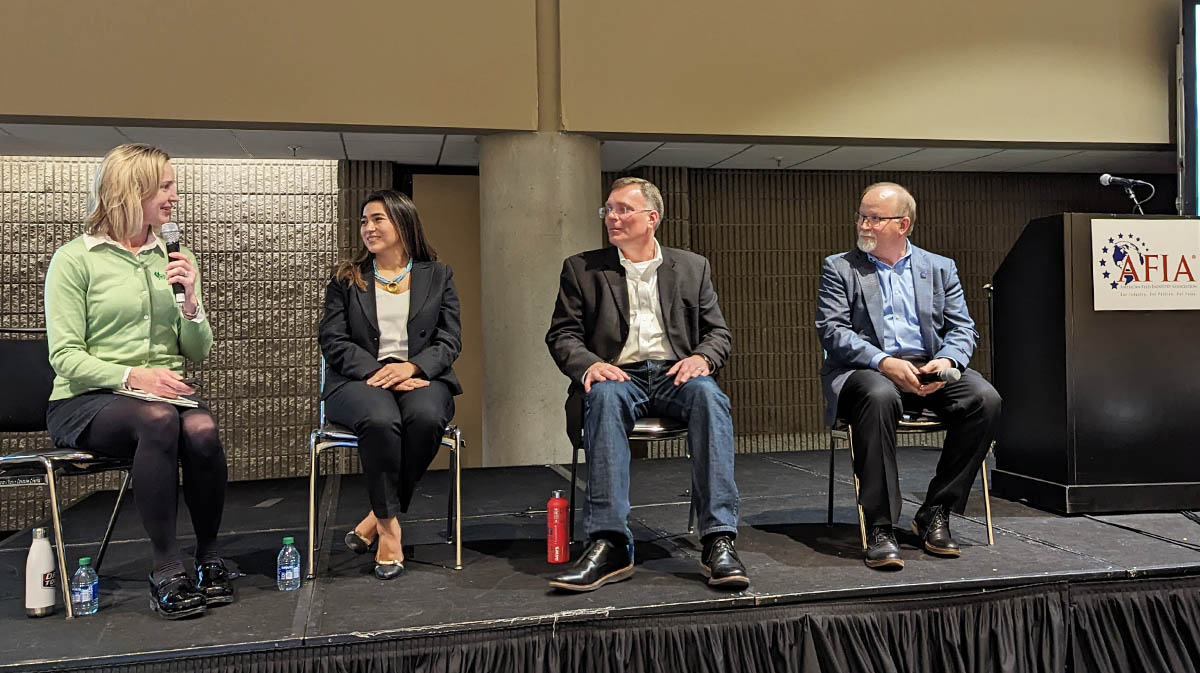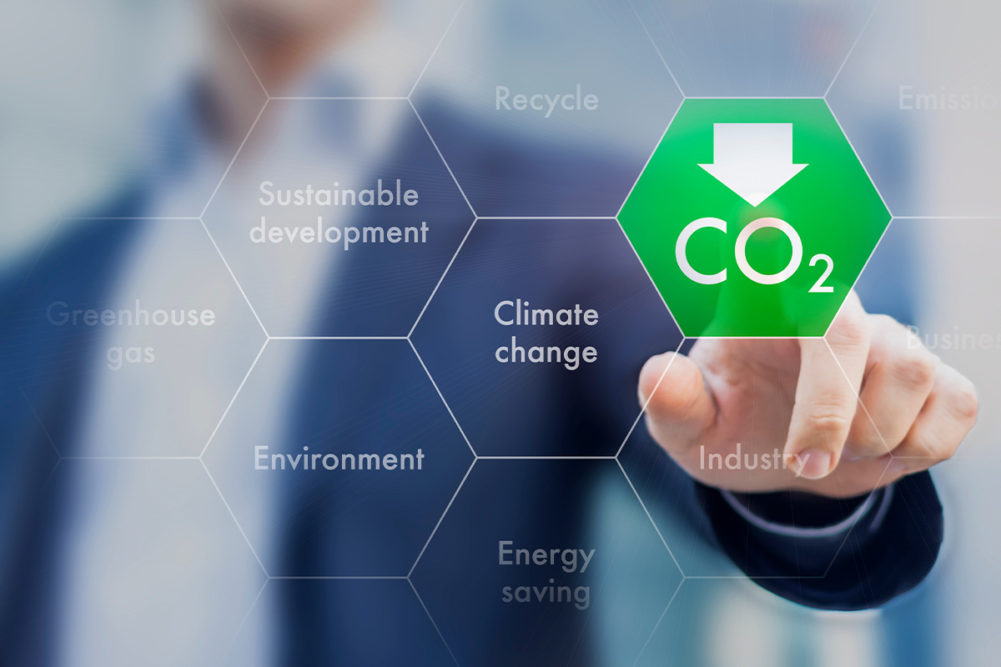This is the second of three articles covering a sustainability panel from the 2023 Pet Food Conference. Get the full story — read the first article here, and the third article here.
ATLANTA — Pet food manufacturers and suppliers alike are being held to increasingly high sustainability standards, driven by consumers, investors and other industry stakeholders. Not only is this a moral issue — it’s also becoming a regulatory issue.
The US Securities and Exchange Commission (SEC) will soon begin requiring public companies to disclose their Scope 1, 2 and 3 sustainability targets, and common export markets for US manufacturers are already employing this level of regulatory accountability. This last portion, Scope 3 emissions, refers to indirect emissions produced throughout a company’s value chain, and necessitates collaboration among raw material suppliers, ingredient manufacturers, and pet food and treat producers to tackle.
This spirit of collaborative problem solving was demonstrated in a panel presented during the American Feed Industry Association’s (AFIA) 2023 Pet Food Conference, held Jan. 24 in conjunction with International Production & Processing Expo (IPPE) in Atlanta.
The panel, moderated by Lara Moody, executive director of the Institute for Feed Education and Research (IFEEDER), featured industry professionals from three corners of the industry — one consultant, one manufacturer and one supplier — who discussed their various strategies and insights for mitigating Scope 3 emissions. Panelists included Temis Coral, senior sustainability consultant at John Beath Environmental, LLC, Nicholas Rozzi, Ph.D., worldwide director of development at Hill’s Pet Nutrition, and Terry Ward, Ph.D., global director of strategy and sustainability at Zinpro Corporation.
 From left: Lara Moody, Temis Coral, Nicholas Rozzi, Ph.D., and Terry Ward, Ph.D. (Source: ©Jordan Tyler – Sosland Publishing Co.)
From left: Lara Moody, Temis Coral, Nicholas Rozzi, Ph.D., and Terry Ward, Ph.D. (Source: ©Jordan Tyler – Sosland Publishing Co.) In our first story about this panel, we covered classifications for Scope 3 emissions, how IFEEDER is supporting the industry in this effort, and what factors are driving this increased focus on sustainability. Below, we share panelists’ insights on how manufacturers and suppliers can define the business case for Scope 3 sustainability in order to garner internal and value-chain engagement in their efforts, as well as the importance of collecting the right data.
Making the business case
“No matter what we do to reduce Scope 1 and 2 emissions, until we get to [Scope 3], we’re not going to have a long term sustainable impact on our carbon footprints,” Rozzi said.
To solidify this point, Rozzi took carbon footprint data from three large pet food manufacturers and averaged that data to create a hypothetical carbon footprint scenario meant to represent emissions for a majority of the pet food industry. He broke these emissions out into two categories — emissions that fall under Scopes 1 and 2, and emissions that fall under Scope 3. Emissions strictly from manufacturing operations were categorized under Scopes 1 and 2, leaving all other operations, like ingredient sourcing, packaging, transportation and others, under Scope 3.
“Scope 1 and 2 emissions are only 9%... We have direct control over that 9% of our carbon footprint,” he said. “Scope 3, on the other hand, represents a tremendously large portion.”
Scope 3 emissions for Rozzi’s “fictional company” accounted for the other 91%. The “elephant in the room” here, according to Rozzi, is ingredients, which account for an estimated 57% of the industry’s carbon footprint. While there are a variety of approaches companies can take to reduce emissions from transportation, logistics and packaging, reducing emissions from ingredient inputs requires manufacturers and suppliers to align their efforts more acutely.
“Reductions in [our supplier’s] carbon footprint will help us reach our reduction goals for carbon footprint, too,” Rozzi said.
Herein lies the example: what a pet food manufacturer may consider under Scope 3 — ingredients — would actually be considered Scope 1 and 2 for the ingredient supplier. And, to make matters more complex, those ingredient suppliers must consider how the Scope 3 emissions of their own raw material suppliers affect their total carbon footprint.
“That becomes, in some cases, quite challenging,” Ward said. “Not only do you have to collect the data, but [consider] how the data was collected… Is it primary data, meaning you actually measured it, or is it secondary data from a database? All those things have an impact. From our perspective, that’s probably one of the most challenging [things].
Mind your data
Coral offered the audience a four-step process for companies embarking on the journey to reduce their Scope 3 emissions:
- Strategize: Start by understanding where the company’s carbon “hotspots” are and where to focus efforts.
- Implement and measure: Create a baseline, start measuring, and develop feasible reduction targets.
- Act and collaborate: Start looking for opportunities to reduce carbon emissions in owned operations, then speak with suppliers and customers on how to best approach these issues together.
- Start telling your sustainability story: “Transparency is really important for your stakeholders [and] for your customers for them to know what you are doing, where you are going now, and what you will do to take the next step,” Coral said.
“You have to have good marketing to be able to get your consumers to realize that buying sustainable is good and that if you’re buying sustainable, then hopefully you’ll be making your science-based targets at the same time,” Rozzi added. “If you’re a publicly traded company, you’re beholden to two masters [stakeholders and consumers], and you have to make them both happy.”
One of the first things companies should do is a material assessment, which will help gauge the importance of each sustainability piece to each company, Coral shared. Understanding where the priorities lie — whether greenhouse gas emission reductions or stakeholder and customer opinions — will help companies determine which sustainability path they should embark on.
“We cannot solve everything at the same time,” she added. “That materiality assessment will tell you where to focus, even if you’re sacrificing a little bit other things that are also relevant for your company.”
A Life Cycle Analysis (LCA) can help companies determine where their “hotspots” are, as well as the best course of action once they’re identified, Coral shared.
“This is a standardized methodology that can help evaluate the impacts of your product or your services across the life cycle — not just one spot, not just your raw materials, not just consumer use, but the whole circle,” she said.
The LCA method is designed to help companies understand the environmental impact of a product in terms of greenhouse gas emissions, water use, health, and other metrics. LCAs are third-party reviewed and can be useful tool for sustainable businesses to back up product claims or showcase how environmental benefits can differentiate their product from a competitor.
“Having an LCA will reflect what you’re doing in your company,” Coral said. “If you have more sustainable practices, if you are using renewable energy, that is something that will show up in an LCA. You can use it as a marketing tool… it will give you all the information about how your product is performing and will also give you insights about how you can improve it.”
When collecting data for an LCA, Ward noted the scope of impact will affect the results.
“You have to define the scope,” Ward said. “From a food animal production standpoint, is the scope at the end of the farm gate or is it at the end of processing? Well, those are two different scopes. Then, with pet foods, it goes all the way to the end consumer. If we want to narrow the scope, we have an easier time measuring it.
“I would also say there’s two sides of the coin, as I see it,” he added. “What is your product’s carbon footprint? We can measure that. We can measure energy use, water use, natural gas, etc. But then, what’s the benefit on the other side? What’s the benefit to Hill’s? When it goes to the consumer, what’s the benefit to that pet owner, and the pet itself?”
Ward noted accounting for all these different impacts — from the source to the process to the consumer — in a single view can be challenging because some of the data is qualitative, not quantitative.
“I think that’s the whole reason that pet food sustainability has such a tremendous impact, because it [involves] the human factor, and that’s the most challenging to quantify… but we have to consider it,” he said.
Rozzi noted that when he was asked to do a value chain analysis for the entire Hill’s Pet Nutrition organization, he found himself up to his neck in data.
“The first thing and probably the most important for everybody to remember: data, data, data,” he said. “You’re going to have a lot of data coming in, you going to have a lot of data going out, and you’re going to try to pull it together. You have to be very organized.”
Having both primary and secondary data will benefit an LCA or value chain analysis, but it’s important to consider where secondary data is coming from to ensure accuracy and relevance. Primary data refers to original metrics derived by a company, whereas secondary data refers to metrics that have already been made available by a third-party (e.g., industry averages). Secondary data can build on a company’s primary data, but is most valuable when it comes from a trusted source.
In Rozzi’s words, “Mind your data.”
For an LCA, the more specific the data, the better. Having primary data on hand to provide supply chain partners will help companies make the most informed decisions about who they’re partnering with and how those partnerships are helping advance Scope 3 emission reductions across the value chain.
“For ingredient suppliers in the space, recognize that as some of your folks who are creating rations or products with your ingredients begin to focus on sustainability as a component of ration decision making, that if your ingredients don’t have good data sets and those ingredients are being entered into the system based on secondary data, it could not be representative of the data that you actually have for your operation,” Moody said. “This is what’s driving some ingredient folks into the LCA space. We’re actually seeing the start of an exponential curve for the number of feed sector folks that are creating their own LCAs, because they’re looking to get better data than what’s out there.”
Rozzi said he uses a proprietary database to manage data for Hill’s Pet Nutrition.
“As much as I do least cost formulation and optimal nutrition, we’re starting to look at trying to minimize our carbon footprint in those same formulations,” he said.
This is what he’s currently referring to as “least-carbon formulation.” Rozzi noted the information supplied to him and to Hill’s Pet Nutrition helps him do a better job of working carbon footprint reductions into his formulation calculations.
“When you look at the data that’s out there — and this is all from databases, this isn’t from any ingredient suppliers — there’s a lot of variety in the numbers,” Rozzi said. “If I make a chicken and rice diet, rice brings in a lot of carbon compared to, say, a corn diet… When you’re trying to balance your carbon, you have a lot of choices out there in formulations. So, the more information and studies you can bring to us, the better informed we can be to use your products.”
This is the second of three articles covering a sustainability panel from the 2023 Pet Food Conference. Get the full story — read the first article here, and the third article here.
Read more about the 2023 Pet Food Conference and other trending topics in the pet food industry.




